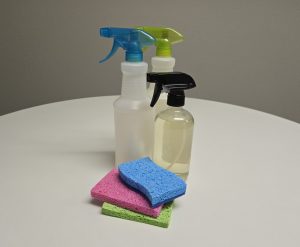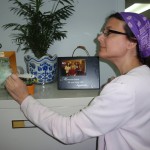
by Judy Corbus | Apr 28, 2025
Spring has sprung and you may feel the urge to give your home a deep cleaning. The American Cleaning Institute finds that 80% of us are doing some type of deep cleaning this spring so you are not alone. Deep cleaning your home after winter gives a fresh restart and boosts your spirits.

Make your own household cleaners to save money and reduce container clutter. Photo credit: Judy Corbus
When choosing cleaning products, keep in mind that you can make your own from ingredients you already may have on hand. You will save money and reduce container clutter with products that can clean multiple surfaces. Here is a list of basic cleaning ingredients:
- Vinegar
- Rubbing alcohol
- Washing soda (can be found near the laundry detergent in most stores)
- Borax (also near the laundry section)
- Mild dish detergent
- Liquid bleach
- Baking soda
- Ammonia
- Water
Here are a few recipes to get you started:
Everyday Household Cleaner
- 2 tablespoons of liquid detergent/soap
- 2 tablespoons of ammonia
- 1 quart of water
Use for all general cleaning jobs.
Window Cleaner
- 1/4 cup rubbing alcohol
- 1/4 cup white vinegar
- 1 tablespoon cornstarch
- 2 cups warm water
Combine all ingredients together in an empty spray bottle and shake well. You will need to shake it a little with each use if you see cornstarch accumulating at the bottom of the bottle. Use crumpled-up newspaper to shine the windows.
Ceramic Tile Floor Cleaner
- 1/4 cup of white vinegar (or more depending on how dirty)
- 1 gallon of water
Typically requires little-to-no scrubbing to remove most dirt and doesn’t leave a film like soap sometimes does when using hard water.
With all cleaning products, remember:
- It is best to mix just what you need and use it all.
- Be sure the container has a label. If you make your own cleaner, always label it.
- Never put cleaners in food containers.
- Store cleaning solutions out of children’s reach.
Note: Use caution when making homemade cleaners! Mixing bleach with ammonia or vinegar will create toxic fumes that are very dangerous to your lungs and breathing!
For additional cleaner recipes, check out:
Reference: Homemade Household Cleaners
An Equal Opportunity Institution.
by Dorothy C. Lee | Apr 14, 2014

Photo credit: Dorothy C. Lee
Spring is officially upon us. There are few rites of Spring more familiar than the annual Spring Cleaning. It is easier and healthier to live in a clean, well-organized home. Spring Cleaning doesn’t have to be synonymous with drudgery, though.
The key to cleaning is being organized and familiar with the uses of different cleaning products. Today’s cleaning methods and equipment make it more efficient and economical to clean. Be an informed consumer when selecting household cleaning supplies. Selecting a few all-purpose cleaners is more economical and requires less storage space.
Make it easy: Get organized. Gather cleaning supplies. Select a few all-purpose cleaners. Put all of your cleaning supplies, brushes, gloves, rags, etc. into one basket and take it with you as you move from room to room.
Clean with ease. Here are some tips that can help you:
- Clean as you go. For example, make your bed as you get out of it.
- Perform preventive measures to avoid big cleaning jobs later. For example, change filters in heating and cooling equipment regularly.
- Plan ahead. Make a list and check off items as you complete the chore. Establish a flexible cleaning schedule.
- Make sure to follow manufacturers’ directions for use and care of items.
- Incentivize by establishing a goal and rewarding yourself when you’ve accomplished it.
- Get in a cleaning mindset. Put on an exercise DVD and think of cleaning as a workout instead of a chore, or put on music you like to move to and let it energize you.
Consider making your own household cleaning supplies…Granny did! Try baking soda, vinegar, and ammonia for cleaning. These old-fashioned cleaners still work today. Making your own cleaners can cost less and be environmentally safe.
Safety considerations should always be followed when making household cleaning supplies. Never mix chlorine bleach with any other cleaning agents, especially ammonia or vinegar. The combination can create toxic fumes. Do not store cleaning supplies in containers that once held food or beverages – this can lead to mistaken identity and accidental poisoning. Clearly label each container. Store all cleaning supplies out of reach of children. Mix cleaning solutions in a well-ventilated area and clean up after using toxic substances. Store containers tightly closed.
Many household cleaners can be made from inexpensive household ingredients. Following are a few DIY cleaning solutions you can prepare yourself:
Multi-purpose Cleaner
1/2 cup ammonia
1 cup baking soda
2 cups warm water
Mix ingredients in a one-gallon container until baking soda is dissolved, and then add enough water to fill the gallon container. Use ½ cup of mixture in a bucket of water to clean floors, walls, woodwork.
Window Cleaner
Mix together 2 tablespoons vinegar and 1 quart water in a spray container. Spray windows and use crumpled newspaper, if desired, to shine windows.
Mildew Cleaner
3/4 cup chlorine bleach
1 gallon water
Mix and put into spray container. Apply to mildewed area; let stand for five minutes; rinse with water.
Disinfecting Solution
3/4 cup chlorine bleach
1 tablespoon liquid soap
1 gallon water
Mix ingredients together. Wipe surface and let stand for two minutes. Rinse and wipe dry or air dry.
Aluminum Cleaner
1 tablespoon vinegar to 1 quart water or
2 teaspoons cream of tartar to 1 quart water
Add solution to pan and bring to a boil. Boil until discoloration disappears. Empty solution, let pan cool, and rinse.
Consider making your own cleaners before you buy. They cost less and are eco-friendly. Be an informed consumer and spring into cleaning!
For further information, visit the University of Florida/IFAS Solutions for Your Life website.
References:
EDIS publication FCS 3149 Hazardous Household Substances: Alternatives That are Relatively Free of Toxic Effects
“Eco-Friendly Alternatives to Commercial Cleaners and Other Household Products,” Environmental Media Services, www.ems.org
“Safe Substitutes at Home: Non-Toxic Household Products,” EnviroSense, www.epa.gov



